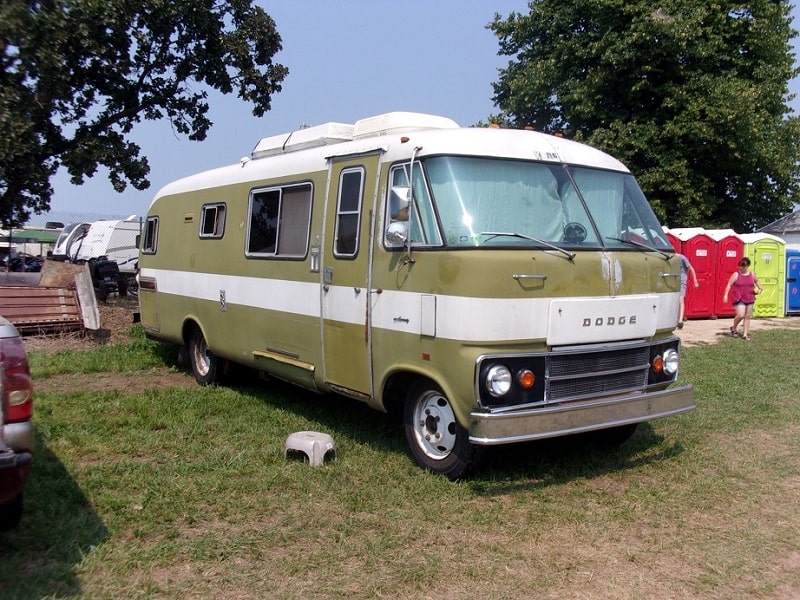This Dodge-Travco motorhome was at the hot rod show in Symco, Wis.
Words: John Gunnell
We have been “kind of looking” for a vintage travel trailer or motorhome. Less than a half mile from our house is a Dodge-Travco motorhome that sits in a field next to a neighbor’s workshop/storage shed. We’ve been tempted to stop and see if the old RV is for sale - but we’re afraid that the owner would say “yes,” because it would be a very big project just cleaning it up, much less making everything in it and on it work again.
Dodge-Travcos were streamlined, fiberglass Class A RVs that rode on a Dodge motorhome chassis. Between 1958 and 1962, a man named Ray Frank owned Frank Industries. In 1961, he made the first of 131 normal box-style motorhomes that he called Frank Motor Homes. They were built in Brown City, Mich. A few years later, Frank made Xplorer motorhomes. Then, he created the bus-like design of Dodge-Travco motorhomes.
The Dodge chassis used under early Travcos employed a modified version of Chrysler Corp’s 318-cid V-8 that was beefed-up with heavy-duty parts. Until 1964, this engine in Travcos was bolted to a 727 TorqueFlite automatic transmission with push-button gear selection. After 1964, the push buttons went out. Travcos could go up to 70 mph. Some later units were probably a bit faster, since they were built with 413- and 440-cid Mopar power plants. Speaking of power, the 318 versions made only about 200 hp.
Travcos had semi-elliptic leaf springs in the front and the rear, with an I-beam axle used up in front. At the rear, there was a live rear axle with dual rear wheels and dual tires. Travco offered a variety of lengths and floor plans. The Travco models were offered in five length configurations: 21-ft. Model 210, 22-ft. Model 220, 27-ft. Model 270, 29-ft. Model 290 and 32-ft. Model 320. The Model 270 was the best-selling Travco.
The Dodge-Travco Motor Home design was considered revolutionary in its day because of its extremely aerodynamic body shape and its fiberglass-over-steel construction. The use of fiberglass eliminated the need for painting the bodies and then maintaining the paint. It also eliminated the dry rot that affected many motorhomes.
Ray Frank’s company went bankrupt in 1963. In 1964, two other men decided to invest their money to obtain patent rights and body molds for the Dodge-Travco. The company was then called Travco Corp., and it went to court to fight a tax law that treated motorhomes as trucks. Travco won the case, but it took until 1971 to earn the victory. However, it helped the entire RV industry. Travco Corp. later became PRF Industries.
The new PRF management enlarged the windows of the Dodge-Travco design and made exterior trim changes. Many mid- ‘60s Travcos were offered in two-tone arrangements combining any one of six colors with white. There were no major design changes in Travcos from the ‘60s through the ‘80s. There were revisions to the grille designs in some years and by the 1970s, the colors were becoming a bit more subtle.
When we started writing about cars in the 19970s, we traveled to Chrysler. Cars were not selling and there were parking lots all over Chrysler’s Highland Park area filled with unsold cars. Chrysler was going broke and needed government loan guarantees to keep the company afloat. The government induced the carmaker to get out of the medium-duty truck niche, and that meant discontinuing the chassis that Travco motorhomes were built on, as well as the 440 V-8. In addition, the gas crisis of the ‘70s impacted Travco sales.
After Travco was gone, a company named Foretravel built a luxury RV using leftover fiberglass Travco body shells, but this effort had nothing to do with Chrysler Corp.
With the current interest in vintage camping trailers and motorhomes growing by leaps and bounds, Travcos are popping up at car shows and traditional hot rod shows, as well as vintage trailer events. They get almost as much respect as a shiny Airstream. Another factor that makes them desirable is their use by celebrities like actor William Shatner, who owned a custom four-wheel-drive Travco, and Johnny Cash. “Travelog” host Charles Kuralt had at least one Travco in the fleet of his “On the Road” television show and another Travco made numerous appearances on the old “Donna Reed Show.”

